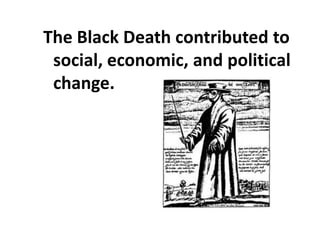
Essay questions chap 6
- 1. The Black Death contributed to social, economic, and political change.
- 2. 1. Discuss how the Black Death contributed to social, economic, and political change during the Late Middle Ages. • Many people died of the Black Death in Europe : about 25 million people – or 30% to 60% of the population – The Black Death contributed to social, economic, and political change.
- 3. 1. Discuss how the Black Death contributed to social, economic, and political change during the Late Middle Ages. SOCIAL CHANGES • Because so many people died, many towns and villages were left empty, markets closed, and workers scarce. • People blamed certain groups of people for the Black Death: 1. flagellants who spread the idea of God’s punishment and 2. Jews Example: a mob in Strausbourg (France) blamed (and killed) the entire Jewish community
- 4. 1. Discuss how the Black Death contributed to social, economic, and political change during the Late Middle Ages. ECONOMIC CHANGES • The labour shortages enabled all surviving workers to ask for higher pay, and this in turn led to rising food prices as well. • While millions died, they left behind all their wealth, which meant that the survivors were, in many cases, suddenly richer than they had been before the Black Death.
- 5. 1. Discuss how the Black Death contributed to social, economic, and political change during the Late Middle Ages. POLITICAL (and economic) CHANGES • this led to a further weakening of the feudal system • serfs discovered they could leave their manors and charge more for their labour elsewhere.
- 6. 3. John Ball’s Speech 1. What advantage do the wealthy have? • They have fine clothes; they have wines, spices, and fine bread; they also have handsome manors.
- 7. 3. John Ball’s Speech • (text) The poll tax took the same amount of money from every person in England (from serfs to nobles). (The serfs did not consider this fair.)
- 8. John Ball’s Speech 2. What reason does Ball give for equality? • He states that all people are descended from Adam and Eve, meaning that they are all human.
- 9. John Ball’s Speech 3.According to John Ball, what are peasants called and how are they treated? • Peasants are called "slaves" and are mistreated • They are sometimes beaten by lords.
- 10. 3. Do you think the English peasants had good reason to revolt in the Late Middle Ages? Why or why not? * The inequities between rich and poor were great. • Peasants were mistreated • They are sometimes beaten by lords. • The nobles had luxuries, such as: fine clothes, wine, spices, and fine bread; • They also had “handsome manors.”
- 11. 3. Do you think the English peasants had good reason to revolt in the Late Middle Ages? Why or why not? • POLL TAX: Everyone had to pay the same amount tax • The serfs did not consider this fair. (They thought the nobles should pay higher taxes.)